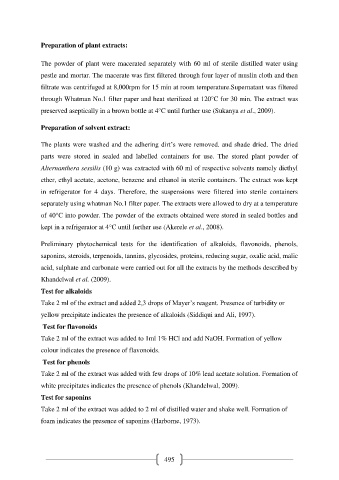Page 505 - e-Book
P. 505
Preparation of plant extracts:
The powder of plant were macerated separately with 60 ml of sterile distilled water using
pestle and mortar. The macerate was first filtered through four layer of muslin cloth and then
filtrate was centrifuged at 8,000rpm for 15 min at room temperature.Supernatant was filtered
through Whatman No.1 filter paper and heat sterilized at 120°C for 30 min. The extract was
preserved aseptically in a brown bottle at 4°C until further use (Sukanya et al., 2009).
Preparation of solvent extract:
The plants were washed and the adhering dirt’s were removed. and shade dried. The dried
parts were stored in sealed and labelled containers for use. The stored plant powder of
Alternanthera sessilis (10 g) was extracted with 60 ml of respective solvents namely diethyl
ether, ethyl acetate, acetone, benzene and ethanol in sterile containers. The extract was kept
in refrigerator for 4 days. Therefore, the suspensions were filtered into sterile containers
separately using whatman No.1 filter paper. The extracts were allowed to dry at a temperature
of 40°C into powder. The powder of the extracts obtained were stored in sealed bottles and
kept in a refrigerator at 4°C until further use (Akerele et al., 2008).
Preliminary phytochemical tests for the identification of alkaloids, flavonoids, phenols,
saponins, steroids, terpenoids, tannins, glycosides, proteins, reducing sugar, oxalic acid, malic
acid, sulphate and carbonate were carried out for all the extracts by the methods described by
Khandelwal et al. (2009).
Test for alkaloids
Take 2 ml of the extract and added 2,3 drops of Mayer’s reagent. Presence of turbidity or
yellow precipitate indicates the presence of alkaloids (Siddiqui and Ali, 1997).
Test for flavonoids
Take 2 ml of the extract was added to 1ml 1% HCl and add NaOH. Formation of yellow
colour indicates the presence of flavonoids.
Test for phenols
Take 2 ml of the extract was added with few drops of 10% lead acetate solution. Formation of
white precipitates indicates the presence of phenols (Khandelwal, 2009).
Test for saponins
Take 2 ml of the extract was added to 2 ml of distilled water and shake well. Formation of
foam indicates the presence of saponins (Harborne, 1973).
495

